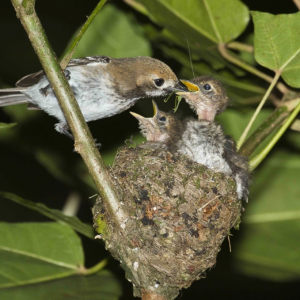Oahu ‘Elepaio
Click on an image to enlarge it
Status: Endemic to Hawai’i, IUCN: Endangered
Hawaiian name: O‘ahu ‘elepaio
Scientific Name: Chasiempis ibidis
Family: Monarchiade
Population: Occurs only on the island of O‘ahu in the Ko‘olau Range between 100 to 550 meters elevation and in the Wai‘anae Range between 500 to 850 meters elevation. The O‘ahu ‘elepaio was abundant and widespread in forested habitats throughout the island in the early 20th century, but has declined steadily. In 2012, the total population was estimated to be 1,261 birds, consisting of about 477 breeding pairs and 307 single males.
Feeding: ‘Elepaio use many substrates for foraging including the ground, logs, rock crevices, snags, and trees. ‘Elepaio eat a wide range of insect prey by flycatching and gleaning. ‘Elepaio use a variety of native and non-native trees for foraging.
Breeding: Pairs remain together throughout the year, and long-term pair bonds are common. Breeding season on O‘ahu is January through July with occasional nesting in the fall months.
Life Cycle: Unlike Hawaiian honeycreepers, both males and females participate almost equally in all aspects of nesting and rearing. Finely woven cup nests are built in a variety of native and non-native trees. Clutch size is 1-3 eggs. Fecundity is low even in areas where predators are controlled. Young are fed by parents for at least a month but remain on their natal territory for up to ten months which may allow young birds to hone their foraging skills.
Cultural Information: In Hawaiian culture ‘elepaio are considered the ‘aumakua, or guardian spirit, of canoe makers. According to one legend, if an ‘elepaio pecked at a koa tree it meant the tree was infested with insects and not suitable for making into a canoe. If instead an ‘elepaio landed on the tree and sang “ono-ka-ia”, or “sweet-the-fish”, it indicated that the wood was sound.
Conservation: O‘ahu ‘elepaio are likely susceptible to the same factors that threaten other native Hawaiian forest birds, including loss and degradation of habitat, predation by introduced mammals, and disease. For O‘ahu ‘elepaio, predation by black rats can cause high nest failure and female mortality.
PRC and O‘ahu ‘Elepaio: Rat control has proven to be an effective method of increasing O‘ahu ‘elepaio nest success and survival of breeding females, if properly implemented, and has become the cornerstone of the conservation strategy for this species. Trapping rats can reduce rat abundance and protect O‘ahu ‘elepaio nests. We have been trapping rats to protect O‘ahu ‘elepaio nests for over 20 years.
Sources: Division of Forestry and Wildlife: Wildlife Program | Oʻahu ʻElepaio (hawaii.gov)
VanderWerf EA. 1998. ‘Elepaio (Chasiempis sandwichensis). In The Birds of North America, No. 344 (Poole A, Gill F, editors.). Philadelphia, (PA): The Academy of Natural Sciences; and Washington DC: The American Ornithologists’ Union.
www.elepaio.org


